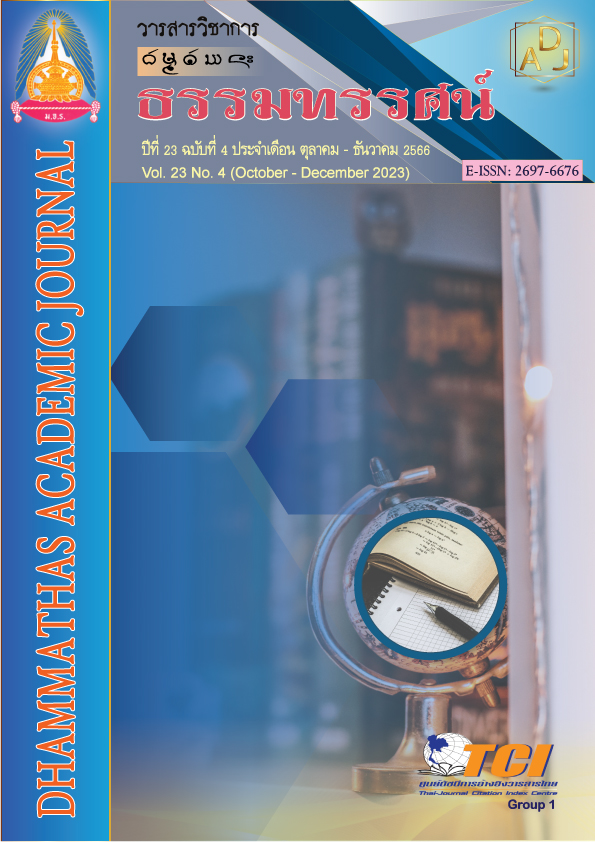Identity Development of Lue Khaja Woven Fabric Patterns at Ban Mae Loi Luang Community, Sri Don Chai Sub-district, Thoeng District, Chiang Rai Province
Main Article Content
Abstract
This participatory action research was for developing a community identity for Lue Khaja woven fabric patterns at Ban Mae Loi Luang Community, Sri Don Chai Sub-district, Thoeng District, Chiang Rai Province. Data were collected from 30 key informants including the weaving group members, community leaders, weaving experts, and representatives from government and private sectors. The research instruments were in-depth interviews, group discussions, observations, and evaluation form for the different fabric patterns and model. The quantitative data were analyzed for standard deviation and mean. For the qualitative data, content analysis techniques and data classification were used.
The results showed that: Ban Mae Loi Luang Community or the Lue Khaja community are names used to call the people in the community whose culture is mixed between Tai Yuan and Tai Lue ethnic groups. Their lifestyles are guided by their use of cotton clothing, local beliefs, traditions, and rituals. Their community has developed their own unique skills and local wisdom for cotton weaving for a long time. As a result of this participatory action research, the community agreed to use the cotton flowers as the model design for representing their unique identity when producing fabrics using their traditional methods. In addition, it was found that the working group of elderly folks had a difficult time weaving because of visual difficulties and therefore the “Yok Khao technique” was substituted to replace “Jok technique” to make the working process easier for them. In terms of evaluating the satisfaction of the selected model design, the results showed a highest satisfaction level. This result helped to confirm the suitability of design and therefore a useful indicator for future development of cultural woven fabrics in this community.
Article Details

This work is licensed under a Creative Commons Attribution-NonCommercial-NoDerivatives 4.0 International License.
เพื่อให้เป็นไปตามกฎหมายลิขสิทธิ์ ผู้นิพนธ์ทุกท่านต้องลงลายมือชื่อในแบบฟอร์มใบมอบลิขสิทธิ์บทความ ให้แก่วารสารฯ พร้อมกับบทความต้นฉบับที่ได้แก้ไขครั้งสุดท้าย นอกจากนี้ ผู้นิพนธ์ทุกท่านต้องยืนยันว่าบทความ ต้นฉบับที่ส่งมาตีพิมพ์นั้น ได้ส่งมาตีพิมพ์เฉพาะในวารสาร วิชาการธรรม ทรรศน์ เพียงแห่งเดียวเท่านั้น หากมีการใช้ ภาพหรือตารางของผู้นิพนธ์อื่นที่ปรากฏในสิ่งตีพิมพ์อื่นมาแล้ว ผู้นิพนธ์ต้องขออนุญาตเจ้าของลิขสิทธิ์ก่อน พร้อมทั้ง แสดงหนังสือที่ได้รับการยินยอมต่อบรรณาธิการ ก่อนที่บทความจะได้รับการตีพิมพ์References
กมลรัตน์ วันไช และคณะ. (2564). แนวทางพัฒนาผลิตภัณฑ์ผ้าทอไทลื้อศรีดอนชัย อำเภอเชียงของ จังหวัดเชียงราย. วารสารบริหารธุรกิจอุตสาหกรรม, 3(2), 46-54.
จุรีวรรณ จันพลา และคณะ. (2559). การพัฒนารูปแบบผลิตภัณฑ์ผ้าทอไทยทรงดำเพื่อสร้างมูลค่าเพิ่มตามแนวทางเศรษฐกิจสร้างสรรค์. Veridian E-Journal, Silpakorn University, 9(2), 82-98.
ณรงค์ เจนใจ และกรชนก สนิทวงค์. (2565). เอกลักษณ์ลวดลายผ้าทออีสานบ้านวังผา ตำบลสันมะค่า อำเภอป่าแดด จังหวัดเชียงราย. วารสาร มจร การพัฒนาสังคม, 7(3), 110-122.
ตุนท์ ชมชื่น และสมชาย ใจบาน. (2558). การเสริมสร้างศักยภาพการผลิต ผลิตภัณฑ์ชุมชน “ผ้าทอกะเหรี่ยง” ตามแนวคิดเศรษฐกิจพอเพียงและเศรษฐกิจสร้างสรรค์: กรณีชุมชนตำบลแม่ยาว อำเภอเมือง จังหวัดเชียงราย. วารสารการพัฒนาชุมชนและคุณภาพชีวิต, 3(2), 203-214.
ธีรารัตน์ ชื่นศิริกุล. (2555). แนวทางการอนุรักษ์ความเป็นอัตลักษณ์ของผ้าฝ้ายทอมือไทยของบ้านร้องกองข้าว ตำบลบวกค้าง อำเภอสันกำแพง จังหวัดเชียงใหม่. เชียงใหม่: มหาวิทยาลัยเชียงใหม่.
วิบูลย์ ลี้สุวรรณ. (2530). ผ้าไทย: พัฒนาการอุตสาหกรรมและสังคม. กรุงเทพฯ: บรรษัทเงินทุนอุตสาหกรรมแห่งประเทศไทย.
สำนักงานมาตรฐานผลิตภัณฑ์อุตสาหกรรม. (2558). มาตรฐานผลิตภัณฑ์ชุมชน ฉบับที่ มผช. 417/2558. กรุงเทพฯ: กระทรวงอุตสาหกรรม.

